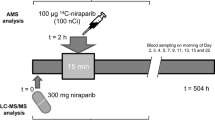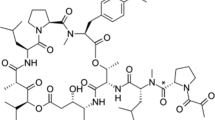Abstract
An excretion balance and pharmacokinetic study was conducted in cancer patients with solid tumors who received a single oral dose of capecitabine of 2000 mg including 50 μ Ci of 14C-radiolabelled capecitabine. Blood, urine and fecal samples were collected until radioactive counts had fallen to below 50 dpm/mL in urine, and levels of intact drug and its metabolites were measured in plasma and urine by LC/MS-MS (mass spectrometry) and 19F-NMR (nuclear magnetic resonance) respectively. Based on the results of the 6 eligible patients enrolled, the dose was almost completely recovered in the urine (mean 95.5%, range 86–104% based on radioactivity measurements) over a period of 7 days after drug administration. Of this, 84% (range 71–95) was recovered in the first 12 hours. Over this time period, 2.64% (0.69–7.0) was collected in the feces. Over a collection period of 24–48h, a total of 84.2% (range 80–95) was recovered in the urine as the sum of the parent drug and measured metabolites (5′-DFCR, 5′-DFUR, 5-FU, FUH2, FUPA, FBAL). Based on the radioactivity measurements of drug-related material, absorption is rapid (tmax 0.25–1.5 hours) followed by a rapid biphasic decline. The parent drug is rapidly converted to 5-FU, which is present in low levels due to the rapid metabolism to FBAL, which has the longest half-life. There is a good correlation between the levels of radioactivity in the plasma and the levels of intact drug and the metabolites, suggesting that these represent the most abundant metabolites of capecitabine. The absorption of capecitabine is rapid and almost complete. The excretion of the intact drug and its metabolites is rapid and almost exclusively in the urine.
Similar content being viewed by others
References
Miwa M, Ura M, Nishida M, Sawada N, Ishikawa T, Mori K, Shimma N, Umeda I, Ishitsuka H: Design of a novel oral fluoropyrimidine carbamate, capecitabine, which generates 5-fluorouracil selectively in tumours by enzymes concentrated in human liver and cancer tissue. Eur J Cancer 34: 1274–1281, 1998
Rustum YM, Harstrick A, Cao S, Vanhoefer U, Yin MB, Wilke H, Seeber S: Thymidylate synthase inhibitors in cancer therapy: Direct and indirect inhibitors. J Clin Oncol 15: 389–400, 1997
Cao S, Lu K, Ishitsuka H, Rustum YM: Antitumor efficacy of capecitabine against fluorouracil-sensitive and-resistant tumors (Abstract). Proc Am Soc Clin Oncol 16: 226, 1997
Ishikawa T, Sawada N, Sekiguchi F, Fukase Y, Ishitsuka H: XelodaTM (capecitabine), a new oral fluoropyrimidine carbamate with an improved efficacy profile over other fluoropyrimidines (Abstract) Proc Am Soc Clin Oncol 16: 226, 1997
Ishikawa T, Utoh M, Sawada N, Nishida M, Fukase Y, Sekiguchi F, Ishitsuka H: Tumor selective delivery of 5-fluorouracil by capecitabine, a new oral fluoropyrimidine carbamate, in human cancer xenografts. Biochem Pharmacol 55: 1091–1097, 1998
Schüller J, Cassidy J, Reigner BG, Durston S, Roos B, Ishitsuka H, Utoh M, Dumont E: Tumor selectivity of XelodaTM in colorectal cancer patients (Abstract). Proc Am Soc Clin Oncol 16: 227, 1997
Budman DR, Meropol NJ, Reigner B, Creaven PJ, Lichtman SM, Berghorn E, Behr J, Gordon RJ, Osterwalder B, Griffin T: Preliminary studies of a novel oral fluoropyrimidine carbamate: Capecitabine. J Clin Oncol 16: 1795–1802, 1998
Mackean M, Planting A, Twelves C, Schellens J, Allman D, Osterwalder B, Reigner B, Griffin T, Kaye S, Verweij J: Phase I and pharmacologic study of intermittent twice-daily oral therapy with capecitabine in patients with advanced and/or metastatic cancer. J Clin Oncol 16: 2977–2985, 1998
Cassidy J, Dirix L, Bissett D, Reigner B, Griffin T, Allman D, Osterwalder B, Van Oosterom AT: A phase I study of capecitabine in combination with oral leucovorin in patients with intractable solid tumors. Clin Cancer Res 4: 2755–2761, 1998
Blum JL, Buzdar AU, LoRusso PM, Kuter I, Vogel C, Burger HU, Brown C, Griffin T: A multicenter phase II trial of XelodaTM (capecitabine) in paclitaxel-refractory metastatic breast cancer (Abstract). Proc Am Soc Clin Oncol 17: 125, 1998
Findlay M, Van Cutsem E, Kocha W, Allman D, Laffranchi B, Griffin T, Osterwalder B, Dalley D, Pazdur R, Verweij J: A randomized phase II study of XelodaTM (capecitabine) in patients with advanced colorectal cancer (Abstract). Proc Am Soc Clin Oncol 16: 227, 1997
Reigner B, Verweij J, Dirix L, Cassidy J, Twelves C, Allman D, Weidekamm E, Roos B, Banken L, Utoh M, Osterwalder B: Effect of food on the pharmacokinetics of capecitabine and its metabolites following oral administration in cancer patients. Clin Cancer Res 4: 941–948, 1998
Reigner B, Clive S, Cassidy J, Jodrell D, Schulz R, Goggin T, Banken L, Roos B, Utoh M, Mulligan T, Weidekamm E: Influence of the antacid Maaloxr on the pharmacokinetics of capecitabine in cancer patients. Cancer Chemother Pharmacol (in press)
Heggi GD, Sommadossi JP, Cross DS, Huster WJ, Diasio RB: Clinical pharmacokinetics of 5-fluorouracil and its metabolites in plasma, urine and bile. Cancer Res 47: 2203–2207, 1987
Author information
Authors and Affiliations
Rights and permissions
About this article
Cite this article
Judson, I.R., Beale, P.J., Trigo, J.M. et al. A human capecitabine excretion balance and pharmacokinetic study after administration of a single oral dose of 14C-labelled drug. Invest New Drugs 17, 49–56 (1999). https://doi.org/10.1023/A:1006263400888
Issue Date:
DOI: https://doi.org/10.1023/A:1006263400888




